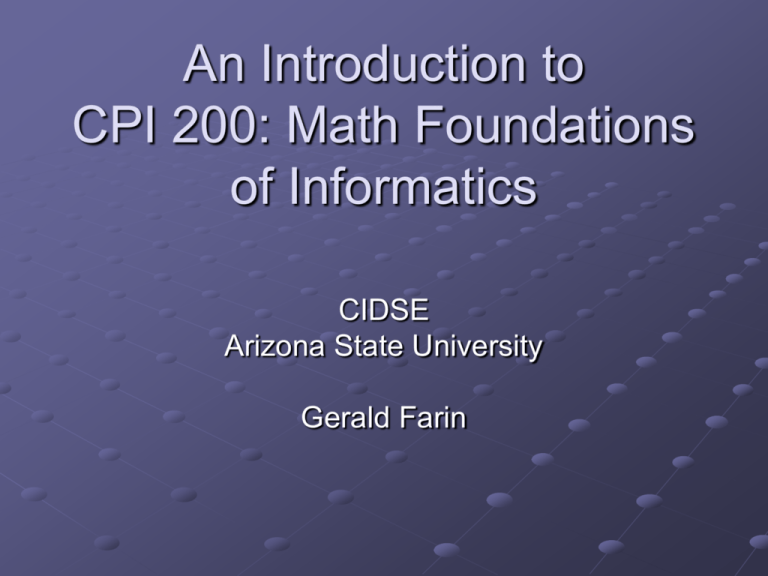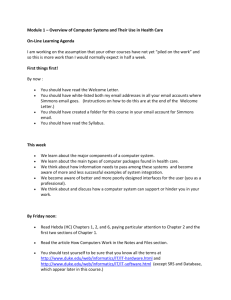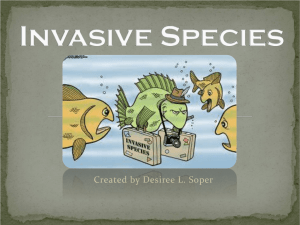An Introduction to CPI 200
advertisement

An Introduction to
CPI 200: Math Foundations
of Informatics
CIDSE
Arizona State University
Gerald Farin
Questions you might have:
Why is this class (math) important ?
What are we going to study?
Relevance to Informatics
How are we going to learn the topics?
Origins of Math
Orient
Chinese
Indian
Islam
Europe
Early Math: Counting
2000BC Babylonia
Mesopotamia (between Tigris & Euphrates rivers) -- Iraq
Writing and base 60 counting
24 hour day, 60 minutes in an hour and 60 seconds in a minute
large numbers and fractions
Calculation for commerce
If 1 cow is worth 3 goats, then how much do 4 cows cost?
Construction of tables
of pre-computed squares and cubes
to aid calculations
http://en.wikipedia.org/wiki/Babylonian_mathematics
Babylonia con’t
Pythagorean triples: a^2 + b^2 = c^2
Systems of linear equations
Quadratic equations
Geometric problems relating to similar
figures
Area and volume calculations
Pi estimate
Greeks
450BC: Babylonian math transferred to Greeks
Thales, Pythagoras: height of pyramids, distance of ship to
shore
Area calculation – early integration (sum over the parts)
Conic section (parabola, ellipse, hyperbola) by
Apollonius
Trigonometry driven by astronomy
Logic
Euclid’s Elements – basis of geometry
http://en.wikipedia.org/wiki/Greek_mathematics
Greeks: Aristotle
384 – 322 BC
Student of Plato; teacher to Alexander the Great
Wrote on many subjects!
More: http://en.wikipedia.org/wiki/Aristotle
Math: Contributions to logic
Focused on theory over experiments
rock falls faster than a feather
centuries later: air resistance discovered
Greeks: Archimedes
287-212 BC – from Sicily
Used math to design innovative machines
Volume and surface area
Archimedes screw pump
Death ray
See http://en.wikipedia.org/wiki/Archimedes
Islamic (Arab) Math
600 – 1600 AD
(Iraq, Iran, Turkey, N. Africa, Spain, India)
Arithmetic (numerical calculations) and algebra
Arithmetic unified math ideas:
algebra, trig, geometry
Al-Khwarizimi (Persian scientist) -- algorithm
Key: preservation of Greek math
11th Century: brought math back to Europe
Europe
16th Century
Earth was assumed to be the center of the
universe
Copernicus and Galileo – study universe
predictions of things out of human reach and
beyond human control
Copernicus
Stars moved east to west each day – in
fixed positions relative to each other
Planets’ movement seemed unpredictable
1543: published sun center of universe
Church: man/earth center of universe
because man is God’s central creation
http://en.wikipedia.org/wiki/Copernicus
Galileo
Father of modern science
1609: Telescope to discover Jupiter’s
moons
Promoted Copernicus’s heliocentric theory
Punished by the Church / Inquisition
Studied effects of gravity
Disproved Aristotle’s finding
http://en.wikipedia.org/wiki/Galileo
Descartes
1596 – 1659 France
Cartesian coordinate system
Analytic geometry: bridged algebra and
geometry
Key for development of calculus
Mind and mechanism ideas -> computer science
http://en.wikipedia.org/wiki/Ren%C3%A9_Descartes
Calculus: Newton & Leibniz
Derivatives, Integrals
Newton’s 3 laws of motion – basis of
physics
“Clockwork universe” – predictable,
deterministic
Awakening
Math played an important role in
increasing human confidence
complicated movement of heavens explained
by math principles
sense of control
Age of Enlightenment
Voltaire and Rousseau
power of reason and the dignity of humans
overthrow of “divine right” monarchies in America
(1776) and France (1789)
Scientific Method
Data acquisition
(Gather empirical data)
Build model
Run model
Hypothesis
analyze model
-- supports hypothesis?
-- new data needed?
-- new model needed?
visualization
Math is at the center of all of this. Math is the language that we use to build
and test models. It also plays a role in data acquisition
Empirical data = Data collected by observation or experimentation in contrast to
theory.
Hypothesis = a proposal intended to explain certain facts or observations; A
scientific idea about how something works, before the idea has been tested.
Scientists do experiments to test a hypothesis and see if the hypothesis is correct.
Topics
Computational basics:
-- floating point numbers, finite precision
Algorithms:
-- definition, types, and basics of complexity
Calculus:
-- differential and integral concepts, limits, continuity
Linear algebra:
-- 2D and 3D geometry basics
Statistical methods
Visualization
Relevance to Informatics
Tools for Memory:
Store, Index, Retrieve
Google {Earth}, XML, SQL, GIS
Tools for Routine Activity:
Represent, Create, Run
Scripting language: on-line purchases,
Rule-based language: tax advisors,
Stored programs: virus scan
Tools for Connectedness:
Communication, Network, Interaction
Facebook, YouTube, IM, Email/spam, Virtual communities, Cell Phone
(iPhone)
Tools for Problem Solving:
Decision making, Planning
Comparison shopping, Flight planners, Games
Tools for Analysis:
Modeling, Inference, Visualization
Excel, Mathematica, Dynamic Simulation, SmartTrade
Integrated Applications:
Biomedical Informatics, educational informatics, Virtual worlds
How are we going to learn the
topics?
Mathematica: http://www.wolfram.com/
ASU has license – computing sites and
available for download
Details later!
References
Eric Schlechter, Why do we study
calculus, www.studyweb.com
St. Andrews University History Topics:
http://www-groups.dcs.st-and.ac.uk/~history/HistTopics/History_overview.html






